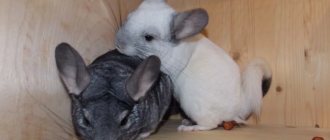Nowadays there is an established opinion that it is impossible to train a chinchilla and it does not respond to it. However, they forget that she sits in their arms and many respond to her name, and this is training, only in a simpler form. In fact, a chinchilla can be trained to other “teams”, you’ll just spend a lot of time on it and it’s not a fact that a harmful chinchilla will do anything.
Some owners train chinchillas every evening, simply because they like it and it has become their hobby, instead of the Internet and TV. I’ll say right away that commands like sit, lie down, give me a paw and voice won’t work here, this is not a dog for you. Rodents are built a little differently, so they can be trained a little differently. In this article you will find information about what you can teach a chinchilla at home, training techniques and what problems the owners of these adorable animals face.
What can be taught
What is the easiest way to teach a chinchilla:
- Get used to your hands
- Teach her to sit on your shoulder
- Respond to your name
- Go to the toilet in a designated place
- Several verbal commands such as: “come to me”, “no”, “home”, etc.
- Sit on the scales
And on this list are skills that many people doubt are possible to train. But nevertheless, with enough effort, you can teach the animal:
- Gopher pose - chinchilla rises on its hind legs when asking for treats
- Kiss – you can teach the animal to kiss you when you bring it to your cheek or lips.
- Walking only on the hind legs is difficult and takes a long time to learn; rarely does anyone succeed.
The intelligence of a furry animal
Most chinchilla owners admit that they are quite smart animals with developed intelligence. However, in terms of their mental abilities, they are significantly inferior to dogs and very slightly to cats. Moreover, chinchillas are smarter than rabbits and rats. They have well-developed hearing and sense of smell.
These animals have an organized nervous system and the rudiments of thinking. Experienced breeders confirm that they remember their name, recognize their owner, and even get bored if they are not cared for for a long time. If you let your rodent walk around the apartment, it will quickly learn to open cabinets and explore all the nooks and crannies. Find out what types and colors of chinchillas there are.
Before you begin training, you should observe the rodent, examine its character and temperament. These furry animals, like people, differ from each other: among them there are choleric, sanguine, phlegmatic and melancholic.
Sanguine people are the most amenable to training - they quickly develop positive and negative reflexes. Cholerics appreciate positive signals and react poorly to negative ones. Phlegmatic people learn longer than others, but their skills are better reinforced. The most difficult thing to work with is a melancholic chinchilla.
Rules for training chinchillas
Before you train a chinchilla, you need to make sure that it is ready for this. Otherwise, you will only cause pain and suffering to this fragile animal.
To start training a chinchilla at home you need:
- Provide her with normal living conditions.
- Regular feed, hay and water.
- Quiet and peaceful room. Especially during training, so that there is no running or screaming.
- The temperature in the room must be correct so that it is not too hot or cold. If the temperature deviates, chinchillas may be depressed
- Your mental and physical condition must be normal, otherwise you may also suffer from this. When the animal is depressed or depressed, it may bite you and release a stream of urine in your direction.
- During training, be sure to reinforce any successes with treats. Give treats only in small pieces so as not to overfeed.
- You need to train in a separate cage if you have 2 or more chinchillas. When a chinchilla is alone, she becomes bored and is more willing to make contact with a person. And in the cage, during training, her neighbors will constantly disturb her, and during the mating season, the male may even bite you)
Basic commands.
The most common command is “come to me.” To learn this action, lure the rodent with a treat, repeating its name. It’s good if your pet’s name contains whistling and hissing vowels, the intelligence of chinchillas reacts positively to such sounds, distinguishing them from others. When the animal approaches, praise it and let it eat a treat, speak in a gentle, calm voice, without raising your tone.
The command “home” and “walk”. To do this, you need to open the cage door, and after the animal leaves the house, bring it back, treating it with a treat. This will help the animal to fix the connection between the action it performed and the receipt of the treat.
The “no” command is one of the most important for young and restless pets. Used when trying to bite a hand or chew furniture. When the rodent begins to bite, it must be gently clicked on the nose, very gently and practically painlessly, so as not to frighten it. Here again the cause-and-effect relationship is triggered and the individual weanes itself off the bad habit. Remember that this connection only lasts a few seconds, so the click and the command must follow each other in the shortest amount of time. During training, you should not raise your voice at the animal, coerce it or force it; if it expresses dissatisfaction and fear, it is better to stop trying and continue training the next day. If there are any signs of distress, allow your pet to return to the house. Pay attention every day, gradually accustoming yourself to regular exercise. Don't skimp on the treats.
How to train a chinchilla to sleep at night
Many owners are bothered by the noise that chinchillas make at night when everyone wants to sleep. Therefore, they are trying to retrain or at least reduce their activity in different ways. Some solve the problem in a different way and make a display case with silent toys, but this requires a huge investment of time or you will have to buy a ready-made one, which costs a lot of money.
If it is not possible to put up a good display case, then you have to teach chinchillas to sleep at night. This does not require special skills; anyone can train their chinchilla on their own.
A few tips that will partially or completely solve your problems:
- THE BEST WAY! Intense walks and games before bed. Chinchillas are very active animals, so they need somewhere to splash out their energy. If you train them in the evening, put them in a bathing area, let them walk around the house and play with them, then believe me, the noise will be much less. With long-term training, they can get used to evening activity and begin to sleep at night.
- Feed them earlier than usual. For example, not at 6-7 o’clock in the evening, but during the day at 2-3 o’clock. This method is not suitable for everyone, because many are at work until late.
- In winter, when it gets dark early, turn off the lights in the room where they are and she will go to bed at about the same time as you.
Causes
Let's look at the main reasons why a cat gets dirty in the wrong place.
Stress, moving
It is generally accepted that cats get used not to the owner, but to the house. This is a controversial judgment, but the territory for a cat plays an important role. Moving is stressful for an animal. In addition, the territory is not marked. The further scenario of the behavior of a pet who wants to “stake out living space” is understandable.
Attempt to establish leadership
Communication between cats is based on smell. “Compositions” in the wrong place are nothing more than territorial markers. This problem is especially relevant for cats picked up on the street, where territorial demarcation is a matter of survival.
Feces in the wrong places is a sign that the cat has not settled into the house and is not confident in itself. The situation becomes more complicated if several animals live in a small apartment. The “struggle for a place in the sun” happens in such a radical way. An ancient instinct kicks in: you need to take the space before someone else does.
Disease
It is necessary to exclude the disease of the animal. Excretion in the middle of the room, on the bed or even on the table is an animal’s desperate cry for help.
Trying to get rid of physical discomfort, the pet changes the place of the “toilet” and wants to attract the attention of the owners to itself. If a demonstrably clean cat begins to shit, the first thing to do is show him to a veterinarian. Once the animal recovers, the problem will disappear on its own.
As the animal recovers, the problem will disappear on its own.
Tray
If the cat does not like the litter, he stubbornly ignores the tray. So try changing the filler. When choosing granules for your cat's litter box, consider the breed of your pet. Long-haired cats are not suitable for compressed sawdust pellets. Filler particles stick to the paws, and the animal experiences discomfort. The best option for them is a tray with a grid.
Does the animal continue to behave mischievously after changing the litter? Perhaps the cat has simply outgrown the litter box or has stopped liking it (this happens too). A sign of this is that the cat does not completely abandon the “toilet”, but does not leave secluded corners. You may have to buy another tray. Cleanliness in cats is instinctive. Some individuals will never do their business in the “toilet” if the filler is not absolutely clean.
Hence - another rule. Don't be lazy to change the filler as often as possible. It is useful not only to change the filler, but also to wash the tray with each replacement.
How to stop a kitten from peeing on the bed
Action plan for weaning a cat from climbing into a flower pot
Another problem is that I don’t like the placement of the tray. Many cats are naturally shy. If the place where the “pot” is located does not seem too secluded to the pet, he begins to look for it at his own discretion. A closed toilet-house is suitable for shy cats. The animal feels safe.
"Mutiny on a Ship"
Often surprises in the most unexpected places are a manifestation of protest. Your pet needs not only a balanced diet. Strokes and kind words are no less important. The proverb about a kind word that is pleasant even to a cat was not invented by chance. Think about it: are you pushing your pet away by being busy or just in a bad mood? Punishing your cat will not solve the problem, but will only make it worse.
Sometimes “hooliganism” is a protest against the appearance of another animal in the house
The cat is jealous, trying to distract attention from the new pet
Just reflexes
It is difficult to understand the real sensations of a cat. Oddly enough, certain objects in the house remind her of a tray (in shape or feel). This explains the animal's attempt to relieve itself in a flowerpot. The only way to prevent this is to exclude your pet from contact with a tempting object. If we are talking about a flower pot, cover the free areas of the soil with foil.
Age
This is one of the most common reasons why an animal shits anywhere. The kitten has not yet acquired the necessary skills. The old cat becomes forgetful. While a baby can be trained to use a litter tray, an older animal often defecates spontaneously. The problem can be solved by monitoring the animal or using special diapers.
How to tame the scales
A very useful skill for owners who constantly monitor their chinchilla’s weight. In general, it is very important to monitor a chinchilla’s weight, because losing weight or quickly gaining excess weight is a symptom of serious illnesses. It is also important to monitor the female's weight during pregnancy to make sure everything is going well.
To ensure that the weighing process does not take much time and is accurate, it is necessary to train the chinchilla to sit calmly on the scales.
- Place the animal on the scales and say the command “Scales”
- Give him a treat right away
- Repeat the "Libra" command while she eats.
- If the animal immediately runs away after eating the treat, try again.
If a chinchilla is already accustomed to being held by hands, then it usually takes 1-2 weeks to get used to weighing, which is considered a very short period of time. In a toga, you will get an obedient animal that will be easy to weigh even without treats and you will spend very little time on this procedure.
Observe the following rules:
- Give the animal a few days to get used to the new place and feel safe,
- Talk to her, let her get used to your voice. The chinchilla's intelligence is capable of recognizing human speech of different timbres and tones,
- You can tell that a chinchilla has become comfortable by its behavior: it no longer huddles in corners, confidently moves around the cage, is interested in external sounds,
- Now you can extend your palm with a piece of treat to the rodent. Calmly, without unnecessary movements, so as not to scare. The baby can shy away fearfully, but natural curiosity will win, after a few attempts, it will come up and sniff the treat.
- The next step is to try touching it under the chin with light, smooth movements. Do not be upset if at first she runs away; after a certain amount of time, the rodent will cease to be afraid and begin to identify the owner with the affection he received.
- If the previous stages have been successfully completed, you can take the animal in your arms, distracting its attention with a treat. This is a rather active and restless animal; you should not expect it to spend a lot of time in your arms.
Problems that arise during training
Some chinchillas are practically impossible to train, as a result of which the owners have problems that they think cannot be solved. First of all, you need to know that each chinchilla is unique and has its own character, which, by and large, was formed in the first years of life. Therefore, it is necessary to study what problems may arise during training and what they are associated with in order to avoid them in subsequent training with the animal.
The worst ones to train are chinchillas that have lived with other owners or spent a long time on a farm or in a pet store. You won't know what conditions they lived in, but most likely they experienced a lot of stress and the longer they were there, the more this life affected them. Some people come across individuals who, for many months, are very afraid of everything and run away from every touch. Such animals are very difficult to tame, but if you spend a lot of time, everything will work out. In general, the animal is friendly, so they quickly get used to people. Chinchillas began to be housetrained only 50 years ago, so they still have a lot of “wild genes”, and we have few instructions on how to do it correctly.
Signs that an animal is depressed:
- Constantly hides and gets scared of you when you approach the cage
- Makes unpleasant noises, especially when you stick your hand into the cage
- During sleep, he may jump up at your approach and take a defensive position.
- When you try to pick it up, it bites and pees in your direction.
You don’t need to get rid of such a chinchilla right away, you just need your own approach to it and a little more time for training. Provide them with good living conditions, a quiet room, and you will notice that after 2-3 weeks the animal will become much calmer.
If your chinchilla is too aggressive, you should contact your veterinarian. He will prescribe you medicines or a list of herbs that will calm her wild temper. Until the chinchilla becomes more or less adequate, keep it away from small children, otherwise they may get bitten.
At what age can you train
Training a chinchilla, like any other animal, should begin as early as possible. It is important not to waste time. Because the older the animal becomes, the longer it will take to train it. The optimal age to start classes is 3–4 months. Up to two months, babies should be close to their mother.
At this time, she is engaged in their training and transfer of skills. They can be separated when the cub is 2.5–2.6 months old . After adaptation to the new conditions, you can try to tame the baby for two to three weeks. You should start from simple commands to complex ones.
Important! You can achieve success in training a chinchilla only with care, patience, affection, attention and the use of various methods of encouragement. During this process, resorting to coercion, aggression and punishment is strictly prohibited.
How to avoid problems during training:
- If your chinchilla swears, pees and runs away from you, then first you need to tame it. There is no need to start with other training until she can sit comfortably in your arms.
- If your chinchilla doesn't respond well, give him more treats. In order not to overfeed the animal, divide the usual portion into 2 or 3. The animal will think that you are giving it a lot of treats, but in fact you gave it the usual portion.
- Do not touch it or take it in your hand unless it comes to you. Until she sits in your arms, you shouldn’t train her or teach her other skills. If you pick it up against her will, then you will cause serious harm to her psyche and she will become even more afraid of you.
- I repeat once again, provide her with normal living conditions, and most importantly, peace and quiet!
- When training a chinchilla, do everything very, very smoothly; sudden movements greatly frighten the animals.
- Talk to the animal in a quiet and gentle voice. The animal may not understand your words, but they will definitely recognize an evil and kind tone.
Useful tips
Beginners and inexperienced chinchilla breeders make many common mistakes during the training process, and therefore often give up. But you just need to follow some rules for working with animals.
What should not be allowed when working with a chinchilla:
- violence (no need to demand something from an animal against its will, this will not bring results);
- punishment (it is useless to punish and scold);
- lack of praise (don’t be afraid to praise!);
- impatience (it is important to be persistent when practicing skills);
- inattention (be sure to study the characteristics of your animal).
The relationship between a chinchilla and a person is built solely on trust. The animal gets used to its owner and is confident in his care, affection, and kindness. Conversely, an insecure, fearful pet is a bad student. Most likely, at your command he will only hide in the corner of the cage. Therefore, if you notice that your chinchilla does not like your lessons, simply return him “home”, postponing training until a better time.
You should not punish or scold the animal. But you should praise more often, even for the simplest actions. In general, the more you communicate with your pet in a friendly tone, the more willingly he will perceive your words. And of course, be calm, patient, persistent: remember that even the smartest animal will not learn a command two or three times. Work with your fluffy in your free time and rejoice at his slightest achievements!
DIY hammock for your pet
A hammock is a simple design, but in order to repeat this craft, special patterns are needed. Only correctly selected material and high-quality tailoring will ultimately provide a good resting place for the chinchilla. After all, each type has its own manufacturing algorithm and additional tricks.
Classic single tier
To sew a classic hammock with your own hands, you will need 2 pieces of fabric, each measuring 45x20 cm (the simplest pattern is a rectangle with arched sides), bias tape for processing and strengthening the cuts, thread, needle and scissors. Sewing occurs in the following stages:
- Each flap cut according to the pattern should be processed along the edges so that the threads do not fray.
- Then you need to fold them and start stitching them - you can put a special filler inside for softness, but an “empty” hammock will also last a long time.
- Places for fastenings are marked along the edges, where gaps need to be made so that the craft can be fixed on the rods and shelves.
- When there is 1 raw corner left, turn the product inside out and sew the last edge by hand - this way all the seams will remain inside.
- Finally, carefully thread carabiners, chains, elastic bands or metal rings through the corners.
When the hammock is ready, firmly attach it to the roof or walls of the cage, focusing on a horizontal position without strong tilts.
How to make a warm bunk hammock
A two-story hammock is sewn in a similar way, but you need to stock up on additional fabric. If the classic version is taken as a basis, then the second part should be calculated in a ratio of 1:1.5 or 1:2 relative to the width - the smaller flap will be the “roof”. Therefore, it is worth having 2 fabrics measuring 45x20 and 2 approximately 45x35 cm, and connecting them in this way:
- Give an arched shape to all 4 blanks (make tapered edges).
- Fold 2 patterns (45x35 cm) and sew them together along the edge.
- Do the same with the second pair (45x20 cm) so that you end up with 2 small hammocks.
- Now put them together so that the narrower part is at the top and sew the edges that match in length (45 cm sides) - you should get a kind of tunnel with a sagging lower part.
Reference! Remember about fixing the carabiners - when combining both parts, they can be immediately inserted and secured with threads.
If desired, you can experiment with a double hammock in terms of parameters: make it symmetrical (but then it will be more difficult for the chinchilla to climb inside) or, conversely, increase the width if the cage parameters allow - the larger the hammock, the more space it will need.
DIY cylindrical hammock for chinchilla
A hanging cradle for a rodent can be made in the shape of a pipe. But in order for the structure to hold, it is necessary to insert a rigid wire on at least one side. To do this, you need to create a kind of “framework” on both sides:
- Prepare 2 square blanks (without arcs) measuring about 50x50 cm.
- Sew them together and run the seam along the edges to avoid splitting the threads. But when wrapping any 2 edges (symmetrical relative to each other), insert the wire inside - the fabric should cover it and fix it near the end so that the wire does not fall inside the hammock.
- Next, you should sew the remaining edges (without wire) together to form something like a cylinder - the shape of the pipe will be held by the wires, forming 2 entrances to the hammock at once.
- The last step is to sew fasteners to the finished craft. They can be fixed either simply at the top (1 ring on each side with a wire) or you can make 2 carabiners at each exit (4 pieces for the whole hammock).
Attention! The cylindrical house will have to be attached only from the top, so options with chains that will stretch to the walls of the display case or shelves are immediately eliminated. It is worth thinking in advance about what the hammock will hang on: in the case of a wooden display case, it can be screwed
From old jeans
Denim fabric is well suited for making a hammock: it is dense, non-slip, and contains natural fiber. The easiest way to use this material is to use old jeans (not too skinny):
- Cut the trouser leg to the desired size - about 30 cm in length.
- On one side, the seam has already been processed and the shape of the pipe is maintained, so you only need to sew 1 edge - turn it 1-2 cm and darn it in a circle.
Reference! If you need a simple single-tier hammock, then the cut-off trouser leg needs to be split along the main seam and get an even piece of fabric
- Next, you need to attach carabiners - it will be enough to attach loops (2 in the case of a tube hammock and 4 for a classic one) to thread the fastenings into them.
Now all that remains is to find a suitable place for it in the chinchilla’s cage and secure it.











